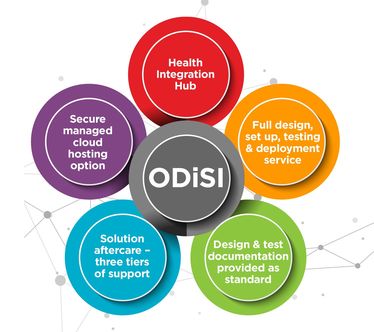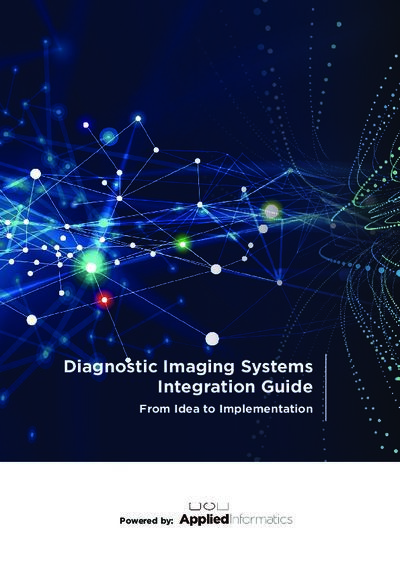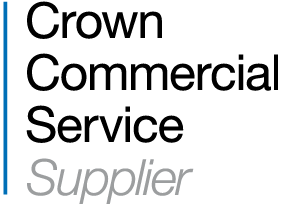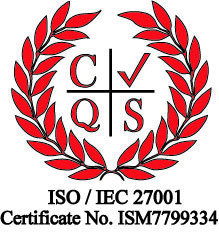Creating a Platform for Digital Growth and Innovation
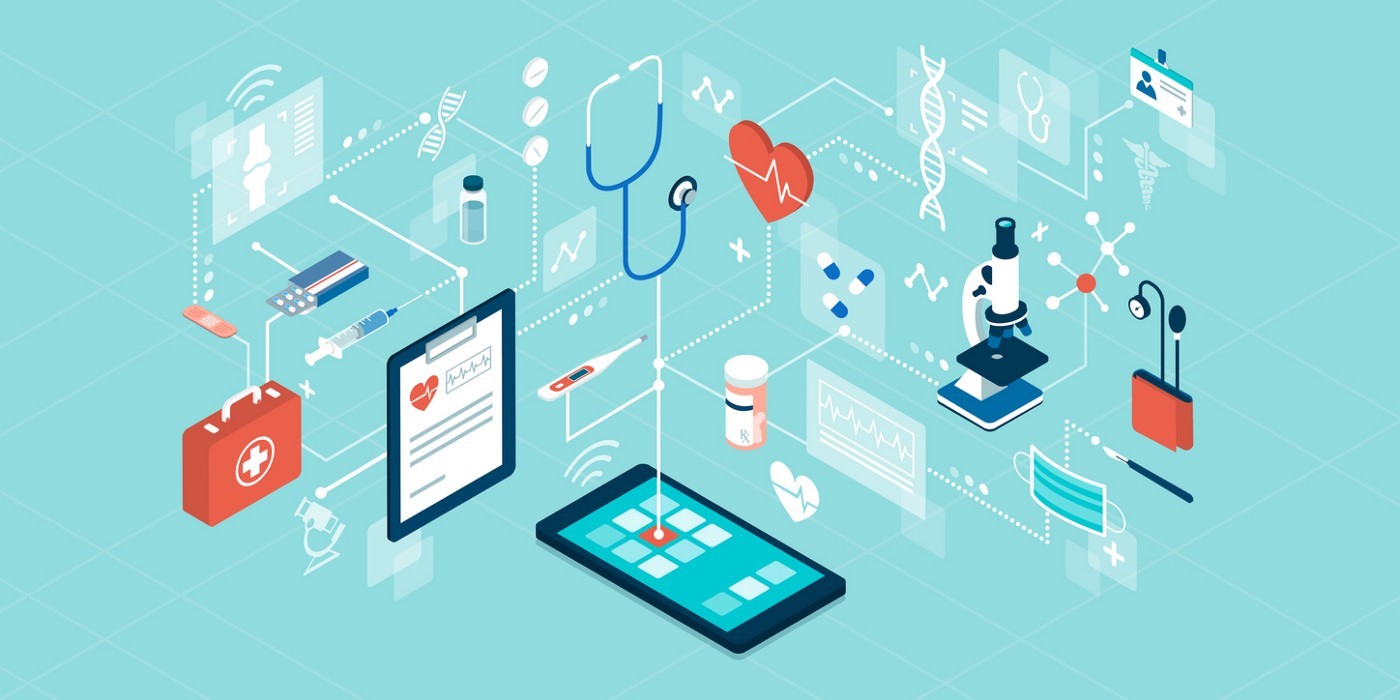
In the rapidly evolving landscape of digital healthcare, the efficient exchange and utilisation of data are paramount to improving patient outcomes, enhancing operational efficiency and reducing costs. It is important for healthcare organisations to realise that even when they choose a centralised Electronic Patient Record (EPR) system they will still be left with a multitude of specialist and other systems which will need integrating if they want to create a single view of the patient and streamline services. Such systems may include specialist departmental applications such as theatre, pharmacy, cardiology or maternity systems; third party order management systems; personal health records; and remote monitoring systems, to mention only a few.
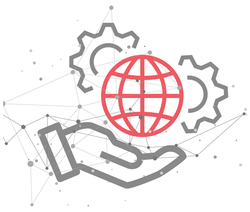
Point-to-Point Integration
Point-to-point integration involves establishing connections between individual systems so that they are able to exchange data directly with one another. With this approach, each system requires a specific integration setup with every other system with which it communicates. While this may seem straightforward initially, it becomes increasingly complex and challenging to manage as the number of systems and connections grows.Advantages of Point-to-Point Integration
- Initial simplicity - point-to-point integration can be relatively simple to set up in the beginning when dealing with a small number of systems
- Direct communication - data flows directly between systems, ensuring real-time data exchange between the endpoints.
Challenges of Point-to-Point Integration
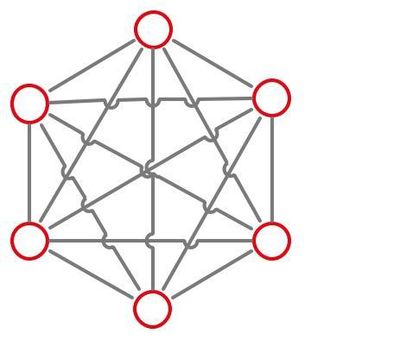
Scalability
As the number of systems increases, the number of connections (integration points) multiplies exponentially, leading to a complex integration landscape that becomes increasingly difficult, expensive and risk-laden to maintain or extend.
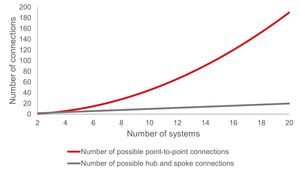
Click to enlarge
In reality not every system will need to communicate with every other system. However, in addition to each system having potentially multiple connections, it must also have knowledge of each and every system to which it connects, such as its network address and data exchange format. This is known as tight coupling and it has several negative impacts that make it challenging to manage any point-to-point integration solution consisting of more than one or two connections.
Impact on implementation
The complex network of tightly coupled systems caused by point-to-point integration increases the chance of functionality being duplicated, often inconsistently, in different places rather than being extracted into reusable modules. Tight coupling and lack of reuse also impacts data standardisation and interoperability (i.e. the ease with which information can be exchanged and understood) as a result of systems having to individually translate between different data formats.
Impact on testing
Tightly integrated systems are typically harder to test. Testing a component in isolation becomes challenging when it cannot easily be separated from its network of dependencies on other systems. This can result in larger, more complex test cases and increased test effort to provide assurance that data can be exchanged correctly and therefore safely.
Impact on maintenance
Each individual integration point must be configured and maintained in isolation leading to duplication of effort and potential inconsistencies when any changes are made. Tightly coupled, point-to-point solutions also suffer from increased risk of defects being introduced when adding, modifying or replacing components. Even small changes to one component might necessitate modifications to several others, leading to unanticipated effects on the network of interdependent systems.
Impact on reliability
Implementation, testing and maintenance issues with point-to-point integration all affect the degree to which the solution is likely to be able to operate as intended without failure. This also includes the solution’s fault-tolerance, i.e. its ability to handle the failure of one or more of its connected systems.
Impact on growth and innovation
The difficulty in maintaining a complex point-to-point configuration inevitably affects the ease with which the solution can be adapted or extended to meet new or evolving requirements. This severely impedes organisation’s ability to grow and innovate digitally and to respond quickly to change, the very benefits integration should aim to deliver.
| Unless your requirement is to connect two or three systems and you are confident that no other systems will need to be integrated in future, then point-to-point integration should be avoided. |
Hub and spoke Integration
Hub and spoke integration entails establishing a central integration hub (also known as an integration or interface engine) that acts as a centralised point for data exchange. The spoke systems connect to the hub, enabling seamless and standardised communication across the healthcare ecosystem.
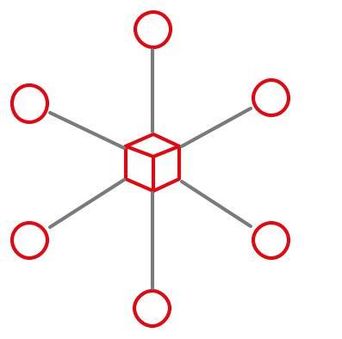
Advantages of Hub and Spoke Integration
Easier to scale
The integration hub provides each connected system with a single integration point. Adding a new system to communicate with any number of other systems in the network involves adding a new connection to the hub. This makes hub and spoke integration solutions inherently easier to scale to meet new requirements.
Easier to implement, test and maintain
Most integration hubs provide inbuilt tools that enable new connections to be added, and subsequently managed, by configuration. Standard functions such as message routing, error handling and logging can be configured, rather than having to be individually coded for each connection. Reducing the need for bespoke coding accelerates development, simplifies testing and maintenance, reduces downtime, and improves overall quality (including reliability).
Enhanced interoperability
Despite growing adoption of digital healthcare standards, one of the primary technical obstacles to creating a shared view of the patient and joining up care across settings is lack of interoperability among different vendor systems. Even systems which do adopt common standards such as HL7 are rarely interoperable out-of-the-box because they implement their own refinements (or profiles) of the standard. Specialist healthcare integration hubs are designed to support digital healthcare standards by default and in addition provide mapping tools and adapters for translating between different data formats. This allows organisations to achieve true interoperability and connect their systems seamlessly.
Support for integration best practices
Many healthcare integration hubs support best practice patterns of healthcare information exchange out-of-the-box, helping to accelerate development and reduce risk. Such patterns include guaranteed message delivery to aid reliability; automation of common workflows such as patient registration, appointment scheduling and diagnostic requesting to reduce administrative burden; and real-time notifications and alerting to ensure timely clinical intervention and improve patient safety.
Improved data management, governance and security
Data management, governance and security are critical aspects of healthcare integration. Hub and spoke integration enables data quality, privacy and security controls to be implemented centrally to ensure consistent enforcement of data governance and security policies across the entire landscape of connected systems.
Cost-effectiveness
Beyond the need to connect two or three systems, hub and spoke integration has the potential to offer significant cost savings. Implementing and maintaining point-to-point connections becomes increasingly resource-intensive, costly and risk-prone as the number of systems grows. By contrast, following the initial setup cost of the hub, the cost of adding and maintaining a new spoke is relatively fixed. Cost savings become even more apparent in the long-term as the integration solution grows and organisations are able to add new systems without the need for expensive reconfiguration or redevelopment.
Conclusion
In the digital era of healthcare, seamless data exchange and interoperability are vital for providing efficient and high-quality care. While hub and spoke and point-to-point integration both facilitate data exchange, the hub and spoke approach offers distinct advantages with regard to scalability, utility, quality and cost. Hub and spoke solutions are highly scalable and, in general, easier to implement, test and maintain. This reduces cost and accelerates delivery. In addition, centralised monitoring and control provide for effective management, governance and security, while out-of-the-box support for interoperability and best practice enhance the quality and reliability of the solution overall.Most importantly, however, hub and spoke integration provides the flexibility and agility to meet the increasing need for healthcare organisations to exchange data seamlessly in their efforts to join up care, improve operational efficiency and harness digital innovation at scale.

